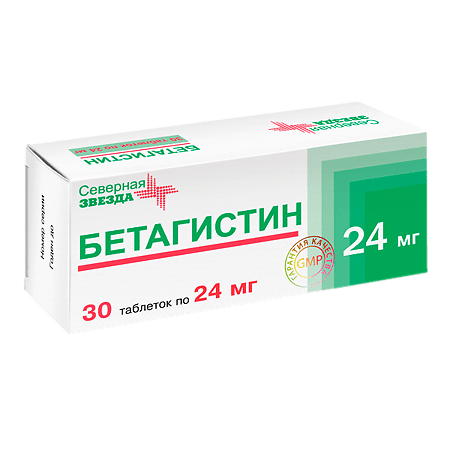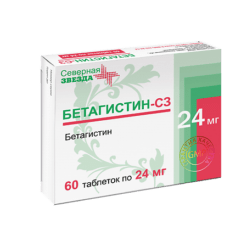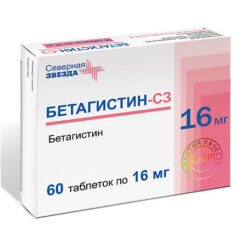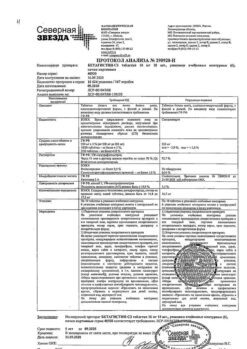No products in the cart.
Betahistin-SZ, tablets 24 mg 30 pcs
€6.66 €5.83
Description
Pharmacodynamics
Betahistine acts mainly on histamine H1- and H3-receptors of the inner ear and vestibular nuclei of the central nervous system. By means of direct agonistic (stimulating) influence on H1-receptors of the inner ear vessels and indirectly through the influence on H3-receptors it improves microcirculation and capillary permeability, normalizes the endolymph pressure in the cochlea and labyrinth. At the same time, betahistine increases blood flow in the basilar artery.
It has a pronounced central effect, being an inhibitor of H3-receptor nuclei of the vestibular nerve. It improves conduction in neurons of vestibular nuclei at brainstem level.
Limits the frequency and intensity of dizziness, reduces tinnitus, improves hearing when it is reduced.
Stable therapeutic effect occurs after 14 days.
Pharmacokinetics
Absorbed completely after oral administration, binding to plasma proteins is low. Time to reach maximum concentration in blood plasma – 3 hours. It is almost completely eliminated by the kidneys as a metabolite (2-pyridylacetic acid) within 24 hours.
The elimination half-life is 3-4 hours.
Indications
Indications
Treatment of Meniere’s syndrome, characterized by dizziness (accompanied by nausea and vomiting), hearing loss and tinnitus.
Symptomatic treatment of vestibular dizziness (vertigo).
Pharmacological effect
Pharmacological effect
Pharmacodynamics
Betahistine acts primarily on histamine H1 and H3 receptors in the inner ear and vestibular nuclei of the central nervous system. Through a direct agonistic (stimulating) effect on H1 receptors of the vessels of the inner ear, as well as indirectly through an effect on H3 receptors, it improves microcirculation and capillary permeability, normalizes endolymph pressure in the labyrinth and cochlea. At the same time, betahistine increases blood flow in the basilar artery.
It has a pronounced central effect, being an inhibitor of H3 receptors in the nuclei of the vestibular nerve. Improves conductivity in neurons of the vestibular nuclei at the level of the brain stem.
Reduces the frequency and intensity of dizziness, reduces tinnitus, improves hearing when it decreases.
A stable therapeutic effect occurs after 14 days.
Pharmacokinetics
Absorbed completely after oral administration, the connection with blood plasma proteins is low. The time to reach maximum concentration in blood plasma is 3 hours. Almost completely excreted by the kidneys in the form of a metabolite (2-pyridylacetic acid) within 24 hours.
The half-life is 3-4 hours.
Special instructions
Special instructions
The therapeutic effect in some cases increases within several months from the start of treatment.
Impact on the ability to drive vehicles and machinery
There may be a decrease in the speed of psychomotor reactions, which reduces the ability to drive vehicles and operate precision machinery.
Active ingredient
Active ingredient
Betahistine
Composition
Composition
betahistine dihydrochloride – 24 mg
Pregnancy
Pregnancy
There is insufficient data to assess the possibility of using the drug during pregnancy and lactation. In this regard, it is not recommended to take Betahistine during pregnancy.
If taking the drug is necessary during lactation, breastfeeding should be stopped.
Contraindications
Contraindications
Hypersensitivity to the components of the drug Betahistine,
pheochromocytoma,
pregnancy,
lactation period,
childhood;
lactase deficiency,
lactose intolerance,
glucose-galactose malabsorption.
With caution: gastric or duodenal ulcer (history), bronchial asthma.
Side Effects
Side Effects
From the digestive system: nausea, dyspepsia.
From the nervous system: headache.
Allergic reactions: hypersensitivity, incl. anaphylactic reactions.
From the digestive system: vomiting, abdominal pain, bloating.
From the skin: angioedema, urticaria, itching, rash.
Interaction
Interaction
Betahistine is a histamine analogue, and the interaction of betahistine with histamine receptor blockers could theoretically affect the effectiveness of one of these drugs.
Overdose
Overdose
Symptoms: nausea, abdominal pain, drowsiness (when taken at a dose of up to 640 mg); convulsions, cardiopulmonary complications (when taken at a dose of more than 640 mg or in combination with other drugs).
Treatment: gastric lavage, taking activated carbon, symptomatic therapy.
Storage conditions
Storage conditions
In a dry place, protected from light, at a temperature not exceeding 25 °C
Shelf life
Shelf life
2 years
Manufacturer
Manufacturer
North Star NAO, Russia
Additional information
| Shelf life | 2 years |
|---|---|
| Conditions of storage | In a dry, light-protected place at a temperature not exceeding 25 °C |
| Manufacturer | North Star NAO, Russia |
| Medication form | pills |
| Brand | North Star NAO |
Other forms…
Related products
Buy Betahistin-SZ, tablets 24 mg 30 pcs with delivery to USA, UK, Europe and over 120 other countries.

















